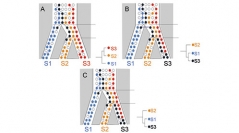

 Comptes Rendus Palevol
12 (6) - Pages 333-337
Comptes Rendus Palevol
12 (6) - Pages 333-337Hybridization is increasingly seen as an important source of adaptive genetic variation and biotic diversity. Recent phylogenetic studies on the early evolution of birds suggest that the early diversification of neoavian orders perhaps involved a period of extensive hybridization or incomplete lineage sorting. Phylogenetic error, saturation, long-branch attraction, and convergence make it difficult to detect ancient hybridization events and differentiate them from incomplete lineage sorting using sequence data. We used recently published retroposon marker data to visualize the early radiation of Neoaves within a phylogenetic network approach, and found that the most basal neoavian taxa indeed show a complex pattern of reticulated relationships. Moreover, the reticulation levels of different parts of the network are consistent with the insertion pattern of the retroposon elements. The use of network-based analyses on homoplasy-free data shows true conflicting signals and the taxa involved that are not represented in trees.
Adaptive radiation, Reticulate evolution, Phylogenetic networks, Transposable elements